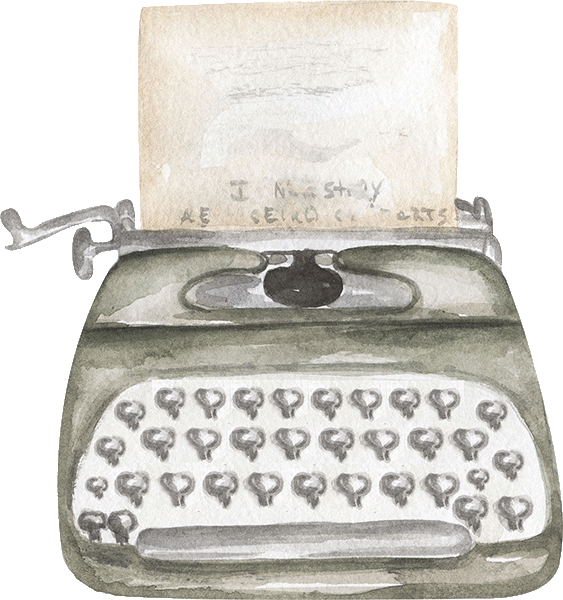Today I’m going to be using my outline for Ivy Introspective to show y’all how I plan for NaNoWriMo, outlining-wise. My current outlining method is my current favorite, obviously, and I hope it’s helpful to you!
Next week I’m hoping to fill you in on some non-outlining ways to prep for NaNo, but an outline is going to be one of your most important tools during November, so you definitely need to think about it.
So let’s get right into it so you can get right into NaNo prep!
How My Current Outlining Method Works
(broken down step-by-step for your convenience)
Step 1: Get a Basic Road Map
A basic road map, for me, is basically the bare-bones details of the plot. Oftentimes I’ll use basic story structure principles to get my main points in place (e.g. first plot point, midpoint, third plot point, climax, resolution, and all points in between!).
I didn’t save mine word-for-word, but it would have looked something like this:
Note: I did remember most of my big plot holes, so this is pretty much exactly what I had, except I added in a few more thoughts in the middle which were scattered here and there.
- First Act: Ivy is struggling to fit in at her new home,
- 1st Half of Second Act: Ivy goes to McCale House, learns music, hangs with Violet, stuff happens.
- Midpoint: ???
- 2nd Half of Second Half: More of that all.
- Third Plot Point: I don’t know, but a low point for Ivy’s self-esteem.
- Climax: Violet and the cliff and all that.
- Resolution: [censored]
As you can see, I don’t have all the details, but I did have a solid climax and resolution, and I did have at least the foundational elements – the beginning, most of the middle, and the end.
And then I fleshed it out to this more detailed point-by-point outlining method:
[This image is missing!]
Step 2: Detailed, Fleshed Out Version
- Hook (0%): Ivy is being mildly verbally abused by a maid because her parents hired out her care for the time being, basically.
- First Half of First Act (0-12%): Set up the scene for everything. Guests arriving, parents easily distracted, Mrs. Chattoway interested in helping but unsure how to.
- Inciting Incident (12%): Ivy [does something that makes her parents seriously concerned for her safety].
- 2nd Half of First Act (12-25%): The decision to send Ivy to McCale House, all the prep, stuff that happens before that.
- First Plot Point (25%): Ivy leaves for McCale House.
- 1st Half of Second Act (25-50%): Arrives at McCale House, meets everyone, starts with therapy, learns about Violet, becomes intrigued by her and wants to help.
- Pinch Point #1 (37%): Ivy realizes how sad Violet is but also that really she isn’t wanted when it comes to comforted her—it’s not her concern, basically.
- Midpoint (50%): Music is introduced.
- 2nd Half of Second Half (50-75%): Deepens relationship with Violet and starts to actively reach out to her. Of course music continues being a thing.
- Pinch Point #2 (60%): Ivy comforts Violet during a tough time.
- Third Plot Point (75%): [Censored for spoilers, but I did finally figure it out. It’s a huge low point for Ivy and disrupts her goal – which is to find a purpose – in a major way, causing her to feel lost and hopeless to an even deeper degree than she started at.]
- 3rd Act (75%-95%): [Also censored, but Ivy overcomes her fears and doubts and makes herself move forward while we continue foreshadowing our final battle.]
- Climax (95%): [details censored, but Ivy confronts the main conflict and perhaps she triumphs and perhaps she doesn’t. What do I look like, a genie who grants my character’s every wish? ?]
- Resolution (100%): [details censored but all those little leftover plot threads are neatly tied up in perky little bows!]
Note that I DID cut down on details to lessen spoilers, but you can definitely see what I’m doing. Just the main points. The things that I know I need to be strongest.
Resources for Last Two Steps
- K.M. Weiland’s Story Structure Database
- The Secrets of Story Structure (complete series)
- Five Reasons You Should Outline (has links out to a bunch more resources)
Step 3: Record Any Major Notes
After I finish with the plot beats, I like to take a break and work on some other details.
In other outlines (I’ve worked on several in the last thirty days or so), I’ve made a brief list of characters, who needs development, and other details I’ll probably forget mid-draft, but that wasn’t so important for Ivy Introspective.
So instead I wrote down things that I was probably going to forget while drafting.
[This image is missing!]
I of course didn’t include all the problems in the above image because I didn’t want you to know I have problems. ? But this basically gave me some notes to consider while I worked on the outline – and will give me some details as I work on the first draft!
These notes would be a lot different for most since I’m rewriting, sort of, rather than writing a basic first draft. But I am intending to tear apart the snippets I am saving, so it’s basically like writing a new draft.
And then came time to flesh it all out …
Step 4: Fleshing It Out
You didn’t think it’d be that easy, now, did you? ? Really, though, it’s time to go from point-by-point to scene-by-scene. (Yes, I am obsessive. Yes, my sanity is fine. I think. Also, the rain in Spain falls mainly on the plain.)
Remember those notes about how the outline works in the image before this one? Check it real quick so you can understand what I did.
[This image is missing!]
But basically, I started with scene one and wrote all the way through the end of the book, beat by beat, action by action, in huge, 300-word paragraphs. (The one above is one of the shorter ones, y’all.)
As I said before, the italics indicate the summary of the whole plot point/section, meaning I know exactly where I am in the entire scope of the plot as well as in that specific scene.
All the way to the end …
(That’s not quite the end, but I forgot to screenshot my resolution, but trust me, it’s there.)
I ended up with 50+ scenes, 7000 words of outlining, and a headache. (Okay, not a headache. More like a writer’s high. But whatever.)
Now … I have never done this before. ? Most of my outlines average 25 scenes, 3000 words, and I’m done. Love Once Lost, my 70k+ hot mess which I actually ripped scenes out of toward the end so I could finish faster (… don’t question my methods) had 41 points in the outline and came to about 4k as far as words go (very different method – much more efficient use of bullet points).
So yeah. This is a beast. Most thorough outline I’ve ever done, I think.
But honestly … it needed done. It took me way too long to finish with The Dressmaker’s Secret without an outline, and I don’t want to be lost in no man’s land with IvIn.
Step 5: Sip some Dr. Pepper* and enjoy your NaNoWriMo
That’s it! You’ve done it – you have a perfect, seamless, flawless outline. Your NaNo experience this year is going to be amazing. After all, how can you fail?
*or your other drink of choice if you’re not a fan of the nectar of the gods
A Couple Possible Questions Answered
Do I need to be so thorough?
Nope. I’m a litttttlleee intense for sure.
What if I don’t have those plot points?
Everyone does. Make them up if you don’t have them. ?
But really. Pick up any book or watch any movie and look at those percentages, and you’ll find those points pretty close to where the book is.
How do I match those plot point percentages up as I write?
You kinda don’t. Just write the scenes you wanted to write as best you can, and the rest is more of a knack thing.
You estimated that this would be a 70,000-word novel. How?
It’s just a guess, but I kind of have an instinct about it. I think I have 40k of new material, essentially.
Does this destroy all the fun of NaNo/writing/etc.?
I honestly think writing is fun enough without having to come up with your plot and characters on the fly. Let’s not make it any funner. ? But really, hardcore pantsers aren’t gonna like this, and that’s fine. You do you. (I don’t know how you do you because I would die, but whatever.)
TTFN!
~Kellyn Roth~
p.s.
Heyyyyy y’all! Was this post helpful? Would you like to see more like it? Also, am I crazy or am I crazy? (And do you have any questions about this all?) And how do you outline (or do you)? Happy October, by the way!



9 Responses
Hey Kellyn! I’m trying to figure out plotting, so I was happy when I saw you did a post on it! My one question is how do you get from the plot points to the scenes? I see how you described the scenes in your outline, but how do you come up with scenes you know will be important to the story?
Yes! I can definitely talk about that. Wish I had more in the post, but it was like 1,500 words, and I was like, “You know, it’s got to be … not this long …”
But I’m writing this down to do a longer post soon. But not soon enough, I imagine, so I’ll create a little answer here that I hope will help. (If not, message me some time or whatever and we can talk more. Or just ask follow up questions here so I remember where they are, lol.)
Basically, I start with the main plot point. Let’s say that’s “Ivy, an 11-almost-12-year-old girl who struggles with a mental disability, is feeling abandoned with her mom distracted by the new dad she doesn’t know or care for, Alice growing up, and Nettie being married. She struggles to find her place in the family and to have a purpose in the world.”
From this, I got four scenes. I wasn’t sure how many I would get at first, of course, but I just started writing down the things that would portray it.
I started out with questions such as “What would show Ivy’s feelings of abandonment by her family?” and “How can I portray that without making her parents and family the worst ever?” (They’re not perfect, but they’re not trying to hurt her.)
This is where the brainstorming comes in. I look at the problems I have and think about how I can solve them. Or rather I look at the plot that needs to happen and see how I can show it.
Then I get to things like, “Well, if Ivy’s parents had given her to the care of a maid who verbally abuses her, Ivy is going to be a mess, and it’s going to trigger the rest of the story.” So I start out showing Ivy being verbally abused by this horrid maid.
The maid gets fired after Ivy’s sister finds out and tells their parents, but now that we had this mini victory, I know I need to get right back into Ivy’s need to seek help for her life.
So of course this means Ivy’s parents need to have guests over at their house which means Ivy will be overwhelmed by their presence which means …
Basically, I keep on thinking of ways to show the plot points through the story.
Another example from later on:
A snippet from a plot point (1st half of second act): “[Ivy] also becomes intrigued by the mystery of Violet Angel but doesn’t believe she can do anything to help.”
How can I show this? Well, first Ivy needs to be introduced to Violet. So she needs to “meet” her – though in this case I’m not introducing her to Violet until later on face to face – at first she just learns about her from others, from hearing her screams in the halls (… don’t ask …), etc. I found out a “fun” way to do that. Next she needs to become interested. Well, people talk about Violet to Ivy, and Ivy needs to relate to her. And something about Violet’s struggle needs to appeal to Ivy – what is that? I had to find that out, too, and figure out how to show it.
Anyway, those are my basic thoughts. It’s, for me, just a matter of brainstorming how to show stuff, how to solve problems I know need solved, etc. Having a very basic, bare-bones structure and working backwards from there is always helpful for me.
Also, note that I have never in my life done this alone. I have friends – actually, many groups of friends – who I am randomly saying things like, “Where can I fit in a cute Ivordy scene?” (lol) or “Where should I put this scene where Ivy and Violet are talking?” And bigger things, too. I wouldn’t be a writer without my writer friends. 😛
Wonderful post– I love looking at behind-the-scenes of authors’ writing methods! I’ve always been an outliner but not hardcore– I will die without an outline, but I feel that each project requires a different sort of outline– therefore, different degrees of thoroughness. (Although that also depends on the amount of time I allot myself. I’m bad at timing outlines what can I say) On that note, I feel like this year’s NaNo novel will need a real thorough outline; otherwise I wouldn’t know what to put in a contemporary novel. xP
Ah, thanks! 😀 Yes, same! It’s so interesting what different people do and how everyone has a very different method.
Haha, yeah, I am working on rewrites of another book, and I just took a quick series of notes on what I wanted to change and ran with it. I knew the plot well enough already. And honestly, I don’t have a super thorough outline with plot points listed most of the time, but I think I do like it. 😛
Haha! Frankly, I wouldn’t know what to put in a contemporary novel, either. I’m so used to historical and an occasional fantasy story …
Lol, I’ve been trying to work on learning outlining, however I’m not an organized person (literally. no one understands. I can not not have a mess. it actually bothers me to have things neat and organized and planned.) but with recent projects I’ve found myself more and more trying to create outlines and attempt organization because I cant seem to keep my goal in mind. (but i fail. I fail so much. what is organization??? *stairs at my outline sheets of chaos and the 50 notes written on my partially written draft…*) I started reading K.M.Weilands book on structuring novels…. Its helpful. At least I know the gist of what I should be seeing XD but I still have terrible organization.
Well, everyone has their own process, and it’s important to seek and find out what works for you. I never really knew outlining existed for the longest time, and when I figured it out, it worked great for me! However, other people just don’t click with it. I don’t get how they can manage it, but I’m not going to pretend they don’t exist for sure!
Thank You for these tips.
Marilyn
For sure!